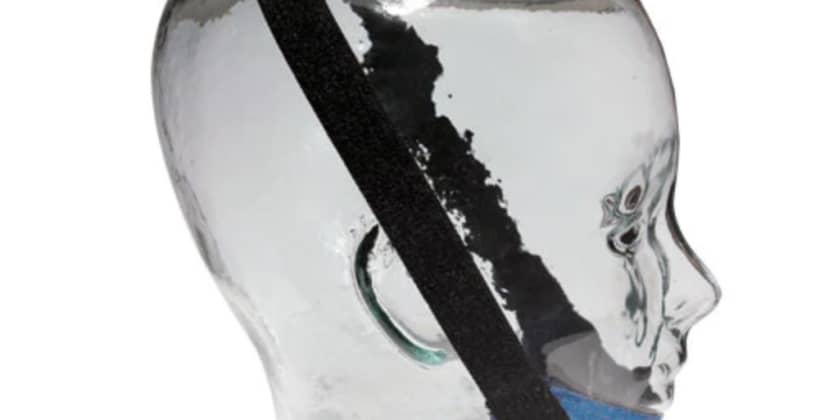When you buy through our links, we may earn a commission. Products or services may be offered by an affiliated entity. Learn more.
Best CPAP Chinstraps
Continuous positive airway pressure (CPAP) machines are a standard treatment for sleep apnea, and many CPAP users use a chinstrap to ensure their treatment is successful. CPAP machines deliver a steady stream of pressurized air via a mask, which can cover the nose, nostrils (in the form of a nasal pillow mask), or the entire face.
Nasal and nasal pillow masks are the most comfortable option for many people, but users must breathe only through their nose to receive the full benefit of their treatment. Elastic CPAP chinstraps provide a solution for users who breathe through their mouth while asleep. They gently hold the mouth closed, reducing air leakage and improving the effectiveness of CPAP treatment.
As with other CPAP accessories, choosing the right CPAP chinstrap can be a complicated and confusing process. A CPAP chinstrap should be effective, durable, and comfortable enough to wear nightly. To help our readers find the best CPAP chinstrap for their needs, we’ll cover everything you need to know before making a purchase.
Our Top Picks
-
Best Overall – Sunset Comfort Chin Strap
View Details
-
Best Value – HDSMNGY Anti-Snoring Chinstrap
View Details
Swipe for more
Best Overall
Sunset Comfort Chin Strap
Use this link for the most current Sunset discount
Use this link for the most current Sunset discount
An adjustable strap and soft chin cup make this offering from Sunset ideal for anyone seeking a comfortable, flexible CPAP chinstrap. We also recommend this product for shoppers with limited shopping funds.

Price
$13
Full Details
The Sunset Comfort Chin Strap lives up to its name thanks to a flexible, adjustable design. A single anchor strap is fully customizable thanks to the hook-and-loop closure, allowing most people to wear the strap comfortably regardless of their facial dimensions. A soft chin cup also ensures a gentle feel without harsh rubbing or abrading.
What Does It Do?
The Comfort Chin Strap can be adjusted using a hook-and-loop closure. You should customize the strap to fit snugly around the perimeter of your head without feeling too tight or constrictive. The chin cup is made of soft, flexible fabric. The cup should cover the entire chin. By holding your chin in place, the strap can improve the quality of your CPAP therapy.
Who It’s Best for
The strap is designed for a universal fit, so most CPAP users should be able to comfortably wear it. Those who sleep on their backs during CPAP therapy can also benefit from using the strap. By holding the chin to ensure your mouth remains closed, the strap can reduce snoring and maintain a tight seal for your CPAP mask. The adjustable design and soft chin cup are suitable for people who have felt uncomfortable using less flexible CPAP chinstraps.
Prices vary by seller, but the Sunset Comfort Chin Strap is fairly affordable and widely available for less than $15. Keep in mind you’ll need to hand wash the strap whenever a cleaning is needed. If you purchase the strap from The Sleep Doctor, you may return it unopened within 30 days of purchase and receive a full refund minus a 15% restocking fee.
Best Value
HDSMNGY Anti-Snoring Chinstrap
The HDSMNGY Anti-Snore Chinstrap offers flexibility, breathability, and excellent overall comfort. A universal fit ensures most adults and children can wear the strap without too much tightness or rigidity, and the ventilated mesh fabric won’t trap heat during the night.

Price
$10
Full Details
While most CPAP chinstraps are relatively affordable, some offer more long-term value than others. The Anti-Snore Chinstrap from HDSMNGY is a prime example. Composed of ventilated mesh that is both flexible and breathable, the strap conforms closely to keep your chin in place without hugging too tightly.
What Does It Do?
The strap is made of elastic mesh fabric that firmly holds your jaw and chin place. Side slits ensure your ears won’t feel scrunched during the night. Two top straps each include a hook-and-loop closure, so you can adjust as needed to accommodate your facial dimensions. The entire strap is ventilated to promote airflow and prevent overheating.
Who It’s Best for
Since the strap is adjustable and designed for a universal fit, most people can wear it comfortably. We also recommend this strap for hot sleepers, people prone to night sweats, and anyone else who tends to feel excessively warm in bed. You’ll need to hand wash the strap regularly to keep it hygienic and odor-free.
If you order the HDSMNGY Anti-Snore Chinstrap from Amazon.com, you’ll receive a 30-day trial with your purchase. Amazon Prime subscribers also qualify for free, expedited delivery.
Best Overall
Sunset Comfort Chin Strap
Use this link for the most current Sunset discount
Shop at Sleep DoctorA flexible, adjustable chin strap with an approachable sticker price.
See More Details

Best Value
HDSMNGY Anti-Snoring Chinstrap
A wallet-friendly CPAP chin strap with a flexible, breathable design.
See More Details

How to Choose a CPAP Chinstrap
Choosing a CPAP chinstrap, like choosing a CPAP mask or other CPAP supplies, is highly personal. What works for one person may not work for another, so it’s crucial to keep your own needs in mind when shopping. Some people need to try more than one chinstrap before discovering what works for them. While chinstraps tend not to be prohibitively expensive, educating yourself about how to choose the right model may make it easier to pick the right option to begin with.
What to Consider When Purchasing a CPAP Chinstrap
The qualities you should look for in a CPAP chinstrap can be broken down into seven different categories. Individual categories may be more or less important to you, but you should consider each one carefully before you make a purchase. However, the most crucial factor when buying a CPAP chinstrap should always be the advice of your healthcare team.
Size & Fit
A CPAP chinstrap that fits correctly should support the jaw rather than holding the mouth shut. It should be comfortable, with just enough tension to keep you from opening your mouth during the night. Many CPAP chinstraps, including adjustable options, are available in different sizes. These may vary between manufacturers, meaning that you should make sure to read reviews and carefully measure your head before purchasing.
Design
CPAP chinstraps are available in a wide range of designs. A standard chinstrap has a single anchor strap across the top of your head, as well as a chin rest made of soft fabric. Other designs have a second anchor strap around the back of your skull, use a mesh cap to anchor two chinstraps for improved stability, or are designed to hook onto your mask headgear.
Mask Compatibility
Although most CPAP chinstraps are designed to work with all CPAP masks, some specialized mask or chinstrap designs may not function well together. Before you purchase a chinstrap, examine both your headgear and the chinstrap to understand how they will fit together. It’s also important to read all available information, as the chinstrap manufacturer may acknowledge any mask incompatibilities.
Materials
Every CPAP chinstrap has three features that usually use different materials: a chin rest, anchor strap or straps, and closures. Some people might prefer one made entirely from cotton with buckle closures, while others might find a polyurethane fabric chinstrap with velcro closures works better for their needs. Customers should consider their comfort preferences, physical limitations, and skin sensitivity before deciding on a chinstrap.
Durability
While the average chinstrap should last at least a year, high-quality CPAP chinstraps can last up to 2 years. Conversely, some chinstraps begin to show signs of wear and must be replaced after less than 6 months. Price is not always an indicator of durability, but models from respected manufacturers usually last longer than less expensive options from lesser-known competitors.
Price
High-quality CPAP chinstraps tend to cost between $15 and $35. Their price is usually directly based on their complexity, meaning that most single-strap models cost less than those with multiple anchor straps or chin supports. Particularly given the affordability of even more complex models, it is crucial to base your purchase on what you need rather than what chinstrap is cheapest.
Warranty
If a CPAP chinstrap has a warranty, it is likely a short-term offer that covers manufacturing defects or flaws. Third-party retailers may also offer their own warranty or satisfaction guarantee. If you are interested in purchasing a CPAP chinstrap with a warranty, your best options will probably be chinstraps made by reputable CPAP manufacturers or sold by dedicated CPAP accessory retailers.
While CPAP chinstraps are less complex than many other CPAP accessories, many customers still have questions even after doing research. Your healthcare team is best positioned to answer any other concerns or in-depth questions you may have about what CPAP chinstrap is right for you.
Frequently Asked Questions
How do I use a chinstrap with a CPAP machine?
Most people who use a CPAP chinstrap wear it beneath their mask’s headgear, but some masks and chinstraps work better when the chinstrap is worn over the headgear. Chinstrap location also depends on a mask’s design, as some have tubing in areas that would be covered or blocked by the chinstrap’s anchor straps. Masks with top-of-head tubing are more likely to conflict with chinstraps worn over the headgear.
How much do CPAP chinstraps cost?
CPAP chinstraps usually cost between $15 and $35 depending on their complexity and durability. Single-strap chinstraps tend to be the least expensive, while complex models with multiple straps or chin supports have price-points at the higher end of the scale. Additional features, such as fleece padding, can also increase the price of a chinstrap. As with all CPAP accessories, it is important to choose the most effective model for your needs even if there are cheaper options available.
Are CPAP chinstraps covered by insurance?
Although some insurers cover CPAP machines, accessories like CPAP chinstraps are not usually covered. These accessories are not considered essential for treatment, so customers are expected to cover the costs themselves. However, it is important to remember that — despite being considered non-essential — CPAP chinstraps are a crucial element of CPAP treatment for people who use nasal masks and tend to breathe through their mouth. If you choose not to use a CPAP chinstrap because it is not covered by insurance, you may want to switch to a full-face mask that can be used regardless of mouth position.
Can I make my own CPAP chinstrap?
Since CPAP chinstraps are a relatively low-cost accessory, we recommend that our readers purchase a chinstrap rather than make their own. Given the apparent simplicity of CPAP chinstraps, it’s no surprise that some people choose to make their own. Homemade chinstraps may appear effective, but the most common designs each have significant downsides. Elastic options, for example, tend to quickly lose their elasticity and therefore their effectiveness. Ace bandages tighten as you wear them, making them an even worse option that can cause muscle strain or other issues.

Still have questions? Ask our community!
Join our Sleep Care Community — a trusted hub of product specialists, sleep health professionals, and people just like you. Whether you’re searching for the perfect mattress or need expert sleep advice, we’ve got you covered. Get personalized guidance from the experts who know sleep best.


